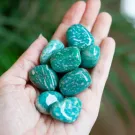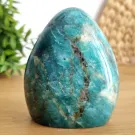Amazonite Gemstone is a beautiful stone with a calming aura and a beautiful blue-green color. Did you know that there are several varieties of Amazonite? Collectors and crystal lovers both hold it in high regard. We will explore the history, origins, colors, and value of Amazonite, as well as its many varieties, in this blog.
Microcline, a feldspar, makes up almost all of amazonite, and the little quantities of water and lead that are present in its crystal structure give it its vivid hues. This stone’s long history of usage in jewelry and health goes all the way back to ancient Mesopotamia and Egypt.
Let’s learn about the Amazonite world and the many types of this gemstone so that we may appreciate its own qualities.
Amazonite Types A to Z: Origins, Mines, and Colors
| Type of Amazonite | Origin | Mines | Colors |
| Amazonite from Brazil | Brazil | Minas Gerais | Bright blue-green |
| Russian Amazonite | Russia | Ural Mountains | Deep green with white streaks |
| Colorado Amazonite | USA | Pikes Peak, Colorado | Sky blue to light green |
| Madagascar Amazonite | Madagascar | Antananarivo | Light green |
| Peruvian Amazonite | Peru | Andes Mountains | Light teal blue |
| African Amazonite | Mozambique, Kenya | Various | Greenish-blue |
| Indian Amazonite | India | Rajasthan | Aqua blue |
| Chinese Amazonite | China | Yunnan Province | Pale green |
| Zambian Amazonite | Zambia | Kafubu | Bright turquoise |
| Canadian Amazonite | Canada | Quebec, Ontario | Pale blue with white veins |
Detailed Descriptions of Amazonite Types

Amazonite from Brazil
Amazonite comes from Brazil in Minas Gerais, a state well-known for its beautiful jewels. The calming turquoise-green color of this Amazonite, which was found in the nineteenth century, is its most distinctive feature. Amazonite, a gemstone mined in Brazil, is highly sought after by gem dealers due to its exceptional purity and lack of impurities.

Amazonite from Russia
In the 1780s, Russian Amazonite especially that found in the Ilmen Mountains became known for the first time. The stunning mixture of high green and blue colors makes this species stand out. Its vivid hue and heavy use in high-end jewelry have given it the nickname.

Amazonite from Colorado, USA
Some of the world’s finest Amazonite specimens have called Pikes Peak Colorado Amazonite, since the 1870s. Typically, the Colorado kind is seen in light blue-green colors. It is a highly sought-after gem for collectors since it is often discovered by miners with smoky quartz and topaz.
Amazonite from Madagascar

In the twentieth century, a new, softer green type of Amazonite was brought to the world via its discovery in Madagascar. Amazonite from Madagascar is ideal for use in fine jewelry and statues due to its typically light color. Because of its rich mineral history, the island is an important participant in the international gems trade.
Amazonite from Canada

Quebec in Canada was the site of the discovery of a stunning pastel-green Amazonite in the early 2000s. The small shade has contributed to its rapid rise in popularity. Although the quantity of diamonds extracted from Canada’s Amazonite mines is low in comparison to other places, their quality is outstanding.
Amazonite from China

Amazonite has been mined in China’s Xinjiang Province since the turn of the last century. The rich green or blue-green colors of Chinese Amazonite are easily identifiable. This kind is now more available to the worldwide market because to China’s growing gem industry.
Amazonite from India

Amazonite mining began in the 2010s in the Tamil Nadu area of India. Usually, the Indian version has a sea green or pastel blue color. Like many other stones, Amazonite is a product of India’s unique geology.
Amazonite from Australia

It was recognized in the nineteenth century that Australia is home to Amazonite, most often found in Queensland. Its unique glassy look and blue-green and teal colors make it easy to spot. Given its relative silence, Australia is nevertheless a reliable supply of high-quality Amazonite.
Amazonite from Austria

There are old Amazonite deposits in the Tyrol area of Austria. Rare and prized in small historical gem collections, Austrian Amazonite has a bluish-green color that made it a prized gem for centuries.
Amazonite from Namibia

Namibian Amazonite, discovered in the Erongo Mountains in the 1990s, is one of the most vibrant varieties. It is known for its bright green and blue-green colors, often showing a strong saturation that appeals to gem collectors worldwide.
Why Is Amazonite Valuable?
The metaphysical powers, beauty, and rarity of amazonite make it a highly sought-after gemstone. The stone is often used for healing and meditation because to its relaxing nature. Because of its stunning blue-green colors, which complement a variety of jewelry styles, Amazonite is highly sought after by collectors for its aesthetic value.
Also, the value of Amazonite is affected by its place of origin. As an example, the historical importance and vivid colors of Russian and Colorado Amazonite cause them to direct a premium price. On the other hand, you may get types from more recent places, like as Madagascar or Canada that are more reasonably priced and still have stunning beauty.
History of Amazonite
Amazonite has been used for thousands of years. Because of its supposed protective properties, the ancient Egyptians fashioned jewelry and amulets from the stone. Its use in jewelry and seals made it a common material in ancient Mesopotamia as well. Although no deposits were ever discovered along the Amazon River, the name of the stone is believed to have originated there.
In more recent history, Amazonite became popular in the 19th century, especially in Russia and the United States. Today, it remains a favorite among gemstone collectors and jewelry designers due to its alluring colors and mystical properties.
Frequently Asked Questions (FAQs)
1. What is Amazonite?
Amazonite is a variety of microcline feldspar, known for its soothing blue-green color. It is often used in jewelry and for metaphysical purposes.
2. Where does Amazonite come from?
Amazonite can be found in various countries, including Brazil, Russia, the USA, Madagascar, Canada, China, and India. Each region produces slightly different hues of the stone.
3. What is Amazonite used for?
Amazonite is used primarily in jewelry. It is also believed to have calming and healing properties, making it popular in crystal healing practices.
4. How is Amazonite formed?
Amazonite forms in igneous rocks such as granite. Its color comes from trace amounts of lead and water trapped in the crystal structure during its formation.
5. Is Amazonite expensive?
Amazonite can range in price depending on its origin, quality, and color. Stones from Russia and Colorado tend to be more expensive due to their rich colors, while other varieties may be more affordable.
6. How can I tell if Amazonite is real?
Authentic Amazonite has a unique blue-green hue that can vary slightly by region. It should also have a glassy or silky luster. If in doubt, it’s best to buy from a trusted seller.
Conclusion
Amazonite is a gemstone of timeless beauty and cultural significance. Everyone who loves gems and jewelry should have one, because to its relaxing colors and fascinating history. Different types of Amazonite are found in different parts of the world and have different colors and patterns. For example, you may get gentle, soft colors from Madagascar and bright greens from Russia.


9 comments
You are my breathing in, I have few web logs and infrequently run out from to brand : (.
THANKS FOR LOVING IT
[…] Amazonite […]
Howdy! This is kind of off topic but I need some advice from an established blog. Is it difficult to set up your own blog? I’m not very techincal but I can figure things out pretty fast. I’m thinking about setting up my own but I’m not sure where to start. Do you have any ideas or suggestions? Appreciate it
Hey there! Great question — and definitely not off-topic at all 🙂. Starting a blog can feel overwhelming at first, but trust me, if you’re willing to learn as you go (which it sounds like you are!), it’s totally doable. I was in the same boat when I started https://gemsstudy.com. I’m not super tech-savvy either, but I found platforms like WordPress really helpful — lots of drag-and-drop tools and tutorials online.
My best advice? Just start simple. Pick a topic you love (for me, that’s gemstones 💎), choose a clean blog theme, and don’t stress about making it perfect. You’ll improve as you go! Feel free to check out my site if you want inspiration or want to see how I set things up. And if you have more questions, happy to help however I can!
I am writing to make you be aware of what a nice discovery our child enjoyed browsing the blog. She even learned a wide variety of details, most notably what it’s like to have a wonderful coaching spirit to make other folks with no trouble fully understand chosen tricky topics. You really surpassed our own desires. Many thanks for delivering these precious, trusted, educational not to mention unique tips about the topic to Mary.
Thank you so much for your kind words! It truly means the world to hear that Mary enjoyed exploring the blog and found it helpful. Our goal at Gems Study is to make learning about gemstones fun, inspiring, and easy to understand—especially for curious minds like hers. 😊 If she ever has more questions or wants to explore specific topics, we’re always here and happy to help. Wishing her all the best on her learning journey!
Thank you for sharing excellent informations. Your web-site is so cool. I am impressed by the details that you have on this blog. It reveals how nicely you understand this subject. Bookmarked this website page, will come back for extra articles. You, my friend, ROCK! I found simply the info I already searched all over the place and simply couldn’t come across. What a great site.
Thank you so much for your kind words! 😊 It means a lot to hear that you found the information helpful and detailed. We’re passionate about gemstones and love sharing what we know with fellow enthusiasts like you. Definitely keep coming back — we’re always adding new content and would love to hear your thoughts or questions anytime. Feel free to explore and let us know if there’s a particular topic you want us to cover next! Thanks again for bookmarking GemsStudy.com — you rock too! 💎✨